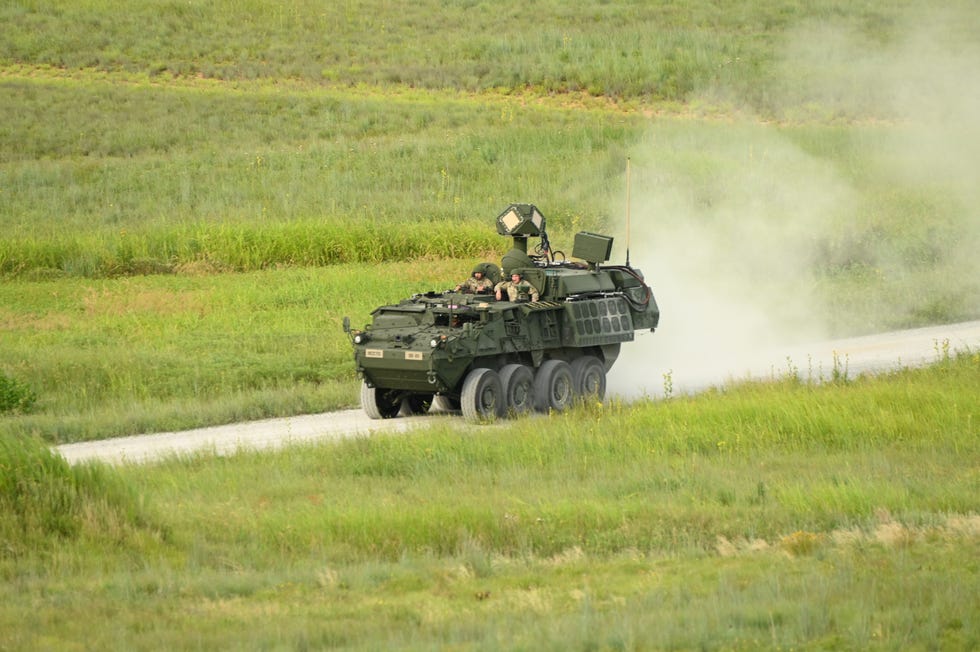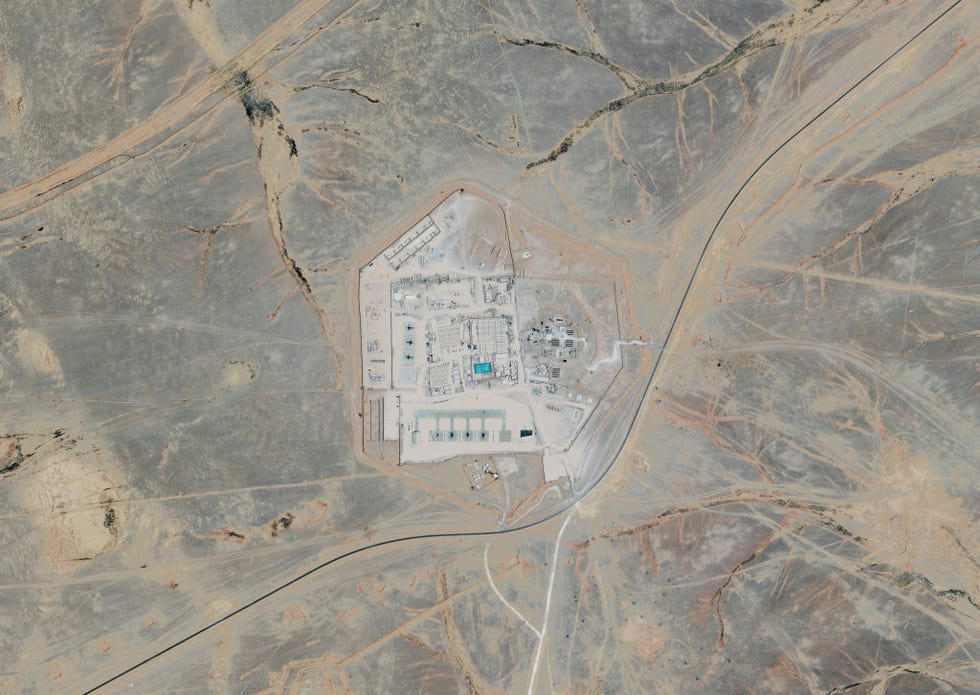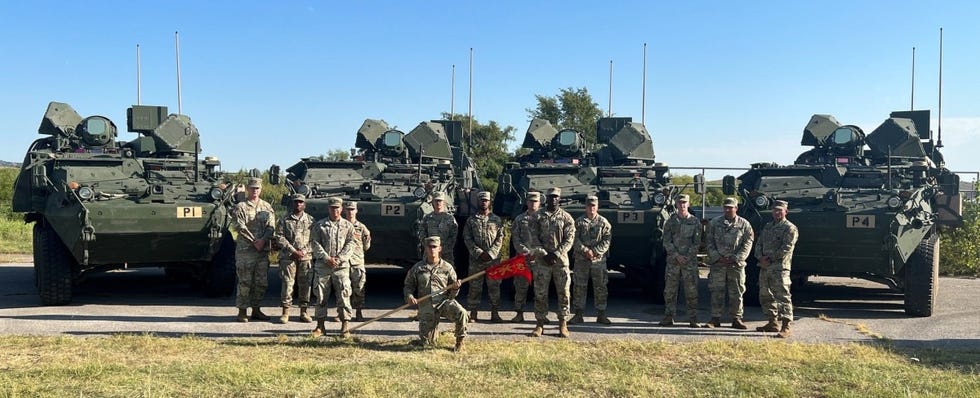KYLE MIZOKAMI

- The U.S. Army has sent its latest air defense system, armed with high powered lasers, to Iraq.
- The DE M-SHORAD system uses lasers to destroy or disable enemy drones, rockets, and artillery.
- U.S. forces in Iraq, Syria, and Jordan have faced more than a hundred attacks from drones and artillery that killed three soldiers and wounded dozens more.
The U.S. Army has deployed its first operational laser weapon system to Iraq. Three Stryker infantry combat vehicles armed with 50 kilowatt lasers, known as DE M-SHORADS, have been deployed in response to lethal drone strikes on U.S. personnel. The brand-new systems were only delivered to the service last September.
Air Defense Laser

A DE M-SHORADS vehicle on the move, September 2023.
According to Army Times, head of U.S. Central Command General Michael Kurilla told Congress that three of the DE M-SHORADS systems are in Iraq “right now” and are being used in “experiments” to “identify their best application.” Army Times further reported that Kurilla “did not disclose preliminary results.”
DE M-SHORADS stands for Directed Energy Maneuver Short Range Air Defense Systems. Developed by RTX (formerly Raytheon) they combine a 50 kilowatt laser weapon with the armored chassis of a Stryker infantry combat vehicle. The laser is oriented to engage aerial targets and is controlled by a radar acquisition system, a targeting sensor, and a beam control system. It also includes the Multi-Spectral Targeting System originally fitted to Predator drones, a ball-shaped sensor turret that includes an electro-optical/infrared camera, a laser designator, and a laser illuminator.

A Syrian rebel drone used to attack the Russian airbase at Hmeimim, Syria, 2018. The drones fielded against U.S. troops in the Mideast are similar.
DE M-SHORADS is meant to provide air defense overwatch for Army ground troops, protecting them from drones—both individuals and swarms. The entire 50kw laser system weighs approximately seven tons, and mounted on the Stryker, it gains armored protection and a top speed of 60 miles an hour. The weapon system is controlled via a ruggedized laptop, and the operator uses an XBox-style controller to operate the weapon.
The use of lasers has several advantages over existing anti-drone systems. Unlike gun or missile-based systems, the laser theoretically has an unlimited number of shots, limited only by the system’s access to electricity. Lasers travel at the speed of light and do not require leading to intercept the target. The system will also not indiscriminately disrupt radio signals the way electronic warfare signal jammers do.
Tower 22 Aftermath

A satellite image of Tower 22, a remote U.S. Army base in the Jordanian desert and the target of drone attacks.
The Army sent the three laser-armed Strykers to Iraq in January, after a major uptick in the number of drone and artillery attacks on American forces in the region. While sporadic attacks have been an issue for years, the attacks ramped up dramatically after the start of the Israeli-Hamas war in October of 2023. The attacks are typically made by local militias under the direction of Iran, and the Pentagon officially considers Iraq a combat zone.
Iranian-backed forces have conducted 150 attacks on U.S. forces since October, inflicting scores of injuries, but no fatalities. The U.S. attempted to brush these attacks aside for fear of escalating the conflict. But on January 28th, 2024, a kamikaze drone struck an American outpost in Jordan known as Tower 22. The drone struck a barracks, killing three U.S. soldiers and wounding several dozen. The attack was carried out by Islamic Resistance in Iraq, an Iranian proxy.
Multifaceted Protection

An image of the first platoon equipped with DE-M SHORADS, assigned to the 4th Battalion, 60th Air Defense Artillery Regiment at Fort Sill. It is likely the three vehicles sent to Iraq are in this photo.
The DE M-SHORADS systems were made to protect U.S. positions against ongoing threats. Not only can they engage drones, the laser is also capable of engaging incoming enemy artillery in mid-flight. RTX claims it can engage RAM, or “rockets, artillery and mortars.” The system is the first in history with the ability to intercept enemy artillery shells in midair before they impact near friendly positions.
This deployment to Iraq is the first for the Army’s tiny force of laser-armed Strykers. In September, the Army assigned a platoon of four Strykers to the 4th Battalion, 60th Air Defense Artillery Regiment at Fort Sill, Oklahoma. Three quarters of that force is now in Iraq. It is unknown if the vehicles are operating together or spread out among various smaller forward operating bases, such as Union III and Ain al-Asad air base.
Kurilla admitted that the laser weapons were “not a panacea,” and encouraged the armed services to send drone-killing systems to CENTCOM—the combatant command responsible for the Middle East. “Give me systems,” he stated in a Congressional hearing, “we will experiment with them, and we will tell you if it works in a real, live environment.” If DE M-SHORADS can hold up against the rigors of real-world use, it could find wider adoption across an Army eager to find an answer to drone swarms.
No comments:
Post a Comment